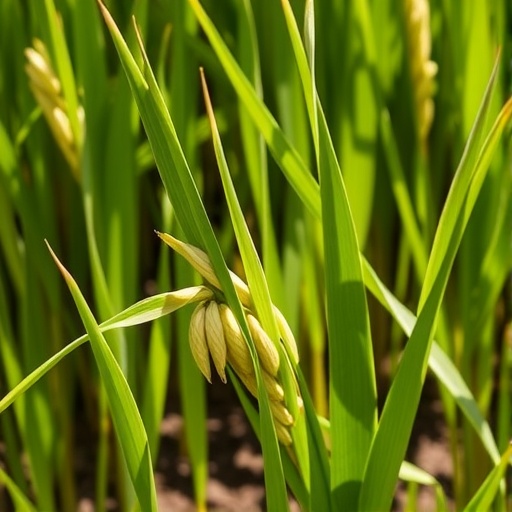In a groundbreaking study, researchers have delved deep into the fascinating world of plant genetics to explore how MicroRNAs (miRNAs) play a crucial role in enhancing light stress resilience in rice. This research has significant implications for global food security, particularly as climate change accelerates unpredictable weather patterns that challenge agricultural productivity. With rice being a staple food for over half of the world’s population, understanding its resilience to various stressors is more critical now than ever.
The study, conducted by an accomplished team consisting of Ghosh, Chakrabarti, and Mukherjee, unearthed compelling evidence that highlights the importance of miRNAs in mitigating the adverse effects of excessive light exposure, a condition referred to as light stress. Traditionally, studies have centered around conventional stress-response pathways in plants, but this research bridges a gap by focusing on the intricate regulatory mechanisms involving miRNAs, which serve as vital regulators of gene expression.
Plants have evolved sophisticated responses to cope with environmental stresses, including light fluctuations. Excessive light can lead to photodamage, which compromises plant health and, ultimately, agricultural yield. By integrating advanced molecular biology techniques with field studies, the research team aimed to highlight the adaptive strategies rice employs to combat light-induced stress. Their findings indicate that specific miRNAs act as molecular switches that can either amplify or suppress gene expression, allowing rice plants to fine-tune their responses to the surrounding light conditions.
Among the essential miRNAs identified in the study, miR156 and miR167 stood out for their significant contributions to light stress resilience. miR156 is involved in regulating developmental processes, while miR167 influences auxin signaling pathways, both of which are crucial for maintaining balance under stress. The interplay between these miRNAs and their target genes forms a complex regulatory network that governs the physiological and developmental changes in rice plants facing light stress.
The application of these findings could be revolutionary. By manipulating miRNA expression through genetic engineering or breeding techniques, scientists could potentially develop rice varieties that exhibit enhanced resilience to light stress. This genetic approach entails either overexpressing beneficial miRNAs or silencing those that lead to stress vulnerability. Such advancements could empower rice cultivation practices, ensuring steadier yields even in fluctuating climatic conditions.
Additionally, the research team employed next-generation sequencing to uncover the global expression patterns of miRNAs under varying light conditions. Their thorough analysis revealed distinct miRNA profiles in rice plants subjected to different light intensities and durations, revealing the dynamic nature of these regulatory molecules in adapting to environmental stressors. This high-throughput approach provided insights that traditional methods often overlook, highlighting the importance of utilizing cutting-edge technologies in plant research.
Moreover, the study’s implications extend beyond light stress resilience. As climate change poses multifaceted challenges to agriculture, findings regarding miRNAs could facilitate advancements in breeding programs focused on developing crops resistant to various stressors, including drought, salinity, and temperature extremes. The versatility of miRNAs in regulating diverse biological processes makes them invaluable targets in the realm of agricultural biotechnology.
As we grapple with the challenges posed by a growing global population and the looming threat of climate change, the insights presented by Ghosh, Chakrabarti, and Mukherjee underscore the urgent need for innovative solutions grounded in science. The research not only broadens our understanding of plant biology but also reinforces the critical role of molecular genetics in addressing food security concerns.
The significance of this research extends to agricultural policymakers and stakeholders who can leverage this information to implement better practices and strategies for sustainable rice production. As climate conditions become increasingly unpredictable, integrating findings from studies like this could enhance resilience on a larger scale, ultimately benefiting farmers and consumers alike.
Furthermore, encouraging the integration of such breakthroughs into educational curricula can inspire future generations of scientists to continue exploring innovative avenues in agricultural research. The potential for miRNAs to reshape our understanding of plant stress management offers a glimpse into a future where crops are enhanced not only for yield but also for their ability to withstand the challenges of a changing world.
In conclusion, the groundbreaking research conducted by Ghosh and his team has opened up new avenues for understanding how miRNAs can bolster light stress resilience in rice. This discovery not only holds promise for developing more adaptable crop varieties but also highlights the importance of continued investment in plant research amidst pressing global challenges. It is an exciting time for agricultural science, with the potential to transform our approach to farming and food production through a deeper understanding of the molecular mechanisms at play.
The research serves as a call to action for the scientific community, farmers, and policymakers to collaborate and translate these insights into practical applications. By doing so, we can work towards a sustainable agricultural future that secures food availability and maintains the delicate balance of our ecosystems.
Subject of Research: MicroRNAs in light stress resilience in rice
Article Title: Unraveling the role of MicroRNAs in enhancing light stress resilience in rice
Article References: Ghosh, R., Chakrabarti, D. & Mukherjee, D. Unraveling the role of MicroRNAs in enhancing light stress resilience in rice. Discov. Plants 2, 231 (2025). https://doi.org/10.1007/s44372-025-00310-4
Image Credits: AI Generated
DOI:
Keywords: MicroRNAs, light stress, rice, agricultural biotechnology, gene expression, resilience, climate change, food security.




